VariOS Resources and Manuals
Various VariOS manuals, software and information. Tried my best to organize it all: a lot of the software is all over the place and Roland has used so many cutesy custom vocabulary bits for all of the packages rather than just creating a single unifying solution.... we have: V-Producer, V-Arranger, VariOS (which can mean different things such as hardware, software or firmware), VariPhrase, Phrase Library, V-Card, UniQuest... and then of course there were other modules like V-Synth. It would probably be best described as a cut-down V-Synth with hardware accelerated VSTs tacked on.
Obviously this is all legacy software and Roland has discontinued support for everything. You will either need an old computer running a 32-bit version of Windows (XP / Vista / 7) or an older G3 or G4 PowerPC mac... or better yet a virtual machine with USB passthrough. I would probably suggest XP or Vista because then you can load it up with other older audio software that's also stuck on XP (but not supported on PowerPC OS X) such as the EMU Morpheus editors, Vocaloid 1, some FS1R stuff, and whatever else. There's also more overhead emulating PowerPC on x86.
There are some hacks to get it working on Windows 10 64-bit though, more on that down below.
Owner's Manuals
VariOS Software Downloads (Windows)
Note: while Roland claims XP is the 'highest' version officially, it appears to work just fine on Vista. The USB driver for Windows 9x class systems is different from the XP one (since drivers for Windows flavours are different than win32 executables).
VariOS Software Downloads (OS X)
V-Card Software Downloads (Windows & macOS)
Roland V-Card VC-1 D-50 Software CD-ROM 1.02
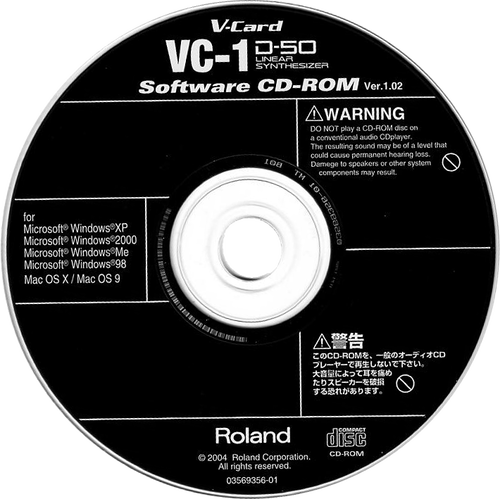
Unfortunately the VC-1 D-50 software editor that comes on CD-ROM (using what Roland calls "UniQuest VC-1"), is a licensed Sound Quest Midi Quest editor and also requires a serial key for installation being provided with every copy. Therefore... I'm not able to legally publish this other than put this reference 'that it's a thing that exists', sorry. If you've purchased a VC-1 V-Card from someone and they haven't included the software and license I would highly suggest you get a refund or have them mark it down by a dramatic margin.
For information on the card itself, I created an article in more detail:
VariPhrase Module Family Differences
The differences between all of these family of VariPhrase modules are kind of strange in many ways in that none of them are truly feature complete to another. What's hilarious is that Roland ended up integrating the VC-1 and VC-2 cards exclusively in the V-Synth XT, but then didn't include the UniQuest VC-1 editing software that you get with VC-1 cards. The cherry on top being that the flagship 'GT' model removed the PCMCIA slot and only integrated VC-2 but not VC-1... oh dear.
Since the VC-1 is not an emulation but the original code running on the VariOS, it can be edited with standard D-50 editors. You could also bum off a copy of UniQuest VC-1 from someone who owns a V-Synth (non-XT) or VariOS.
| Feature | VA-76 | VP-9000 | V-Synth | V-Synth XT | V-Synth GT | VariOS |
|---|---|---|---|---|---|---|
| VariPhrase Standalone Editing | Yes | Yes | Yes | Yes | Yes | No, Requires V-Producer |
| VC-1 Integrated | N/A | N/A | No | Yes | No | No |
| VC-2 Integrated | N/A | N/A | No | Yes | Yes | No |
| Supplied VC-1 UniQuest Editor | N/A | N/A | Yes | No | N/A | Yes |
| COSM | No | Yes | Yes | Yes | Yes | No |
| AP Synthesis | No | No | No | No | Yes | No |
| V-Arranger | Yes | No | No | No | No | No |
| Twin D-Beams | No | N/A | Yes | N/A | Yes | N/A |
| Virtual JP-8 / TB-303 | No | No | No | No | No | Yes |
| Number of PCMCIA Slots | N/A | N/A | 1 | 1 | N/A | 1 |
*It's possible there might be error(s) in the above chart due to the fact I don't own all of those machines and documentation is quite scarce.
I'm a little surprised Roland only included a single PCMCIA slot. That means if you wanted to use VC-1, VC-2 and have the external storage... you need to swap between all three. Hell, it might even make more sense just to buy multiple modules if not a V-Synth XT. The VC-1 had to include RAM on itself as a result of this problem since there's no secondary PCMCIA slot for a CF card.
If you wanted to cover mostly everything, you'd need to purchase a: VA-76, V-Synth GT and VariOS.
Modified Driver for Windows 10 (64-bit)
User Chris7 at rolandclan, created a little hack to get the VariOS communicating natively on Windows 10.
I've managed to re-purposed the UM-ONE mk2 midi driver to work with the VariOS. It seems like Roland uses the same Midi/USB protocol for both devices. You won't have access to the midi ports on the rear from Windows, as the UM-ONE mk2 device only has a single pair of MIDI in/out.
To install you need the UM-ONE mk2 driver. The download from the Roland site doesn't contain the actual driver, the only way I know to get the driver is to attach a UM-ONE mk2 to your machine and then find the file required (RDWM1115.SYS and Uninstall.exe).
For this to work you will also need to turn off Signed Driver Enforcement. This is detailed here.
To create the driver installation you need to create a folder structure called Driver and set out as follows:
- Driver/Files/RDWM1115VariOS.SYS (copy and rename "RDWM1115.SYS" from the UM-ONE mk2 driver)
- Driver/Files/RdUninst.dat (See below)
- Driver/Uninstall.exe (Directly from the UM-ONE mk2 driver)
- Driver/rdif1115VariOS.inf (see below)
Once you have rebooted you should be able to right click the .inf file and install the driver, confirming that you want to install the unsigned driver.
- Here is the rdif1115VariOS.inf file I used.
- The RdUninst.dat.
These are the md5sums of the files I used from the UM-ONE mk2 driver:
- 9defc92c643caacc8d16e551aae30128 Uninstall.exe
- 3ac42c82db24a10fa8153a305fc277de RDWM1115VariOS.SYS
VariOS Boot Modes (Five Modes!)
As far as I understand there's no way to enter the V-Producer mode when you have VC-1 or VC-2 plugged in the PCMCIA slot, you simply have to remove VC-1/VC-2 without going into the menu modes and let the unit boot normally... boo...
- V-Producer Mode (ensure VC-1 and VC-2 are *not* present and only PCMCIA CF storage)
- D-50 Mode (insert VC-1 in the PCMCIA slot and power on normally)
- Vocal Designer Mode (insert VC-2 in the PCMCIA slot and power on normally)
- Virtual Synthesizer Mode: press the [menu] button + [left cursor] button while powering on, then from the screen choose one or the other:
- Select program (VP1 = VariOS-8)
- Select program (VP2 = TB-303)
This does mean you'll be rapidly powering the VariOS on and off as you need to switch between VariOS modes, and constantly eject the cards out to go between V-Producer / VC-1 / VC-2 modes. You also can't switch between the synthesizer modes in real time, you also have to power off the unit and back on if you want to go from the 303 to the Jupiter-8.
I'm not sure why the manual doesn't cover this, or why Roland didn't add the V-Producer mode as a 'select program' option under the menu + left cursor boot option. Whatever...
It also appears some settings like the MIDI channel and a few others do not remain persistent, so you'll have to go into the menu each power up cycle and change them again.
VariOS-8 Configuration and Setup
It was pretty fiddly getting the virtual MIDI configuration down to work with my USB MIDI keyboard, you need to set your keyboard as the 'Through' Input (microKEY2 Air in the picture) and then Roland VariOS MIDI as the 'Through' Output:
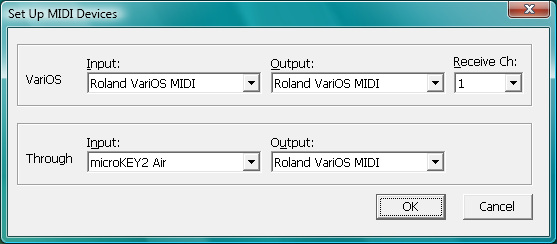
When opening the VariOS-8, there's four 'Detail' buttons that expand for more options, these windows stay open persistently as you flip through presets so I would highly recommend opening them all so you can see all of the values for patch programming:
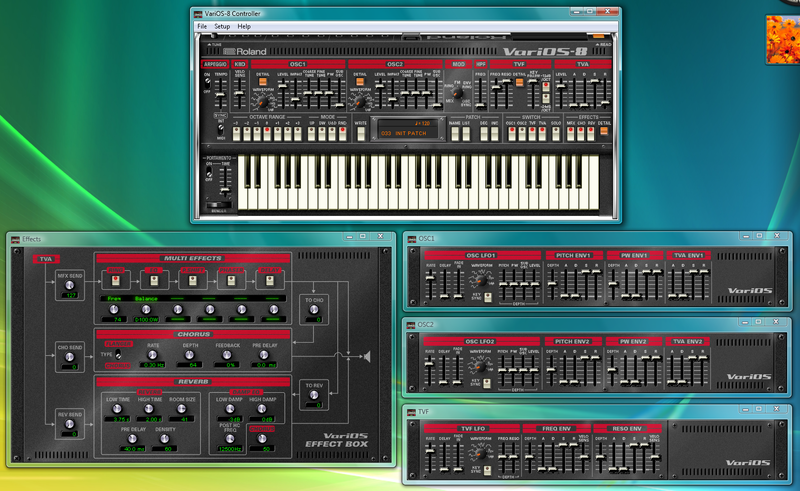
There are also four different skins you can apply to the VariOS-8 (back when VSTs and the like were all the rage for skins, I remember ReFX Nexus having skins that cost over $80 USD per skin back in the day):
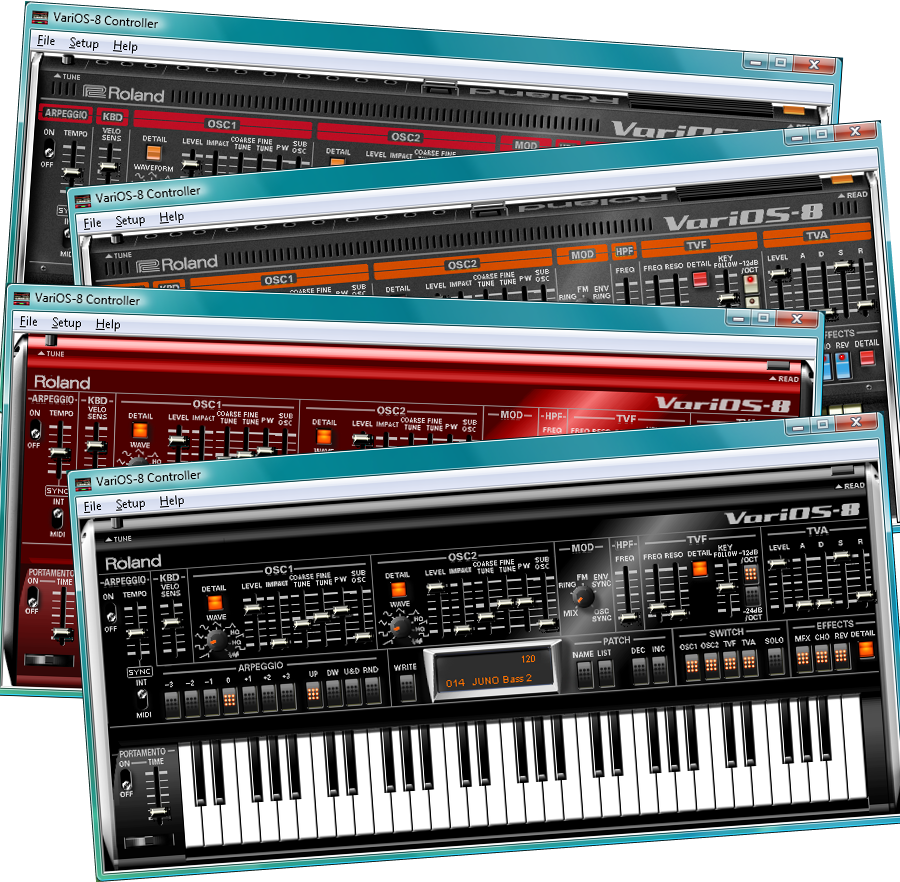
Something weird happened after I started using VariOS-8, the HPF value kept creeping up. After much scrutiny, it turns out the *pitch* knob at the front is mapped to this, and it's gotten a little crusty over the years and so it was drifting causing the HPF to constantly drift up as a result.
VariOS BCR2000 External Control
Roger (The MIDI Maniac) created a printable template and custom piece of software (using Mountain Utilities) to control the Roland VariOS externally with the BCR2000 so you don't need to have a Windows XP laptop plugged in on life support.
It should be noted that the BCR2000 is now a discontinued device of its own right, so you'll have to grab one second hand.
Troubleshooting V-Producer (Where's My VariOS Drive?)
After installing the VariOS USB driver and launching V-Producer without the PCMCIA card, I got this error:
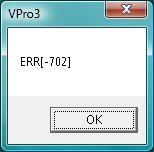
"VPro3: ERR[-702]"
Of course I didn't know what it meant, but it simply means there's a problem with the VariOS storage being present. Roland's manual omits this error from their list.
There wasn't a whole lot of documentation going over getting V-Producer fully functional under Windows XP/Vista/7. Once the driver is installed and USB communication is working, that alone isn't enough for V-Producer to be fully functional. You need to make sure the PCMCIA slot is *empty* or populated with a storage card, if VC-1 or VC-2 are inserted it will boot to those and you can't bypass them to get it into V-Producer mode.
Aaaand once removing the VC-1 card and letting the unit naturally boot into V-Producer mode we can see the USB disk from the VariOS mounts successfully:
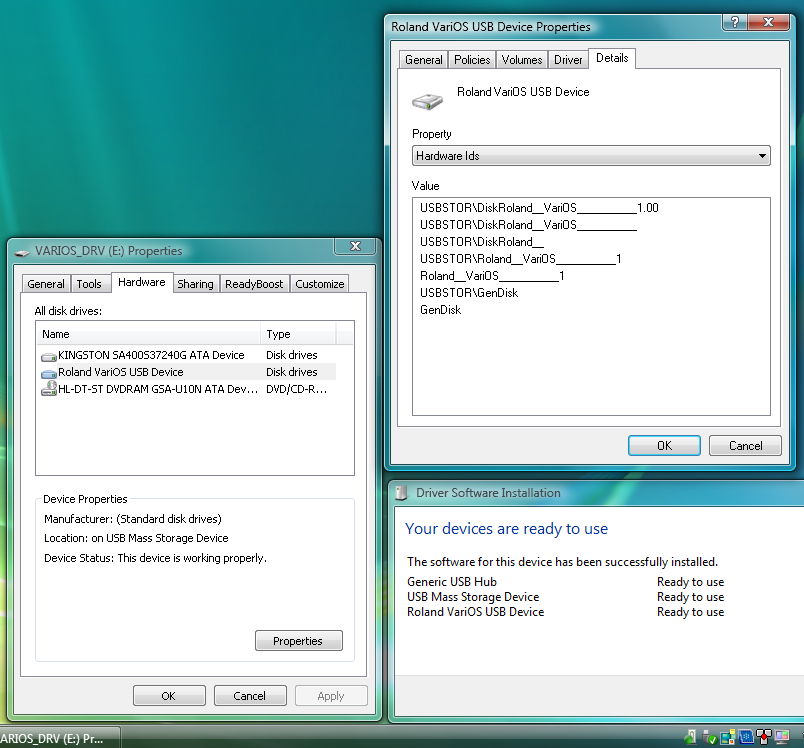
I don't know why the USB disk is saying VariOS 1.0 there in device manager when V-Producer says the VariOS is 1.07. I'm guessing the whole VariOS device is littered with conflicting versioning.
VariOS CF Cards and PCMCIA Adapter Support
Another thing not really documented are which cards and capacities the VariOS (and I suppose also V-Synth) are supported.
From what I understand, CF card capacities ranging from [128 MB] to [8 GB] should be supported across all V-Synth and VariOS machines.
In terms of which PCMCIA-to-CF card adapters work (in 2023), the Transcend ones seem to be okay.
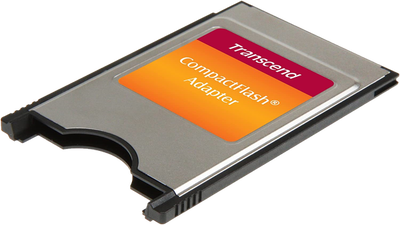
VariOS-8 Project .INI hack
User vsyn7425 at rolandclan, discovered a trick regarding the .INI file on the VariOS with the PC card so you don't have to do as much swapping.
Usually when booting up the VariOS-8 from PC CARD, the OS will link to project folder "VA.prj". However by introducing a "V-Synth Project.ini" file to the PC CARD we can change that relationship by altering the project folder name and altering the contents of the ".ini" file to the same name. This means we can load all our projects on the PC CARD in different folders rather than having to swap out the contents of "VA.prj" all the time. Also the names of the folders can be something more meaningful like "JP8000.prj" etc. So now when we want to change project folders we simply edit the "V-Synth Project.ini" using notepad. Please find attached a "V-Synth Project.ini".
Extra V-Synth parameters on VariOS-8
User vsyn7425 at rolandclan, discovered that the V-Synth GT utilizes the VariOS-8 engine (or rather, the VariOS-8 engine is just a reduced version of the V-Synth's virtual analog engine), and as such you can load V-Synth parameters to VariOS-8 not normally present on the virtual plugin's interface.
Hi all. Some of you may not be aware that patches made on any of the V-Synths even the V-Synth GT that use at least one an analog element can be played in the VariOS-8.
Find attached four projects (.prj) files that contain patches originally for the V-Synth GT which show off the capabilities of the VariOS-8 far extend what the VariOS-8 controller can provide. To load simply swap the contents into the "VA.prj" or use the method in my earlier post to link the folders using a V-Synth Project.ini. Have fun.
Rotten 303 Emulation
Like most digital modules or software, the VariOS doesn't escape a lot of issues that plague digital resonance. The tone of it is completely different from a real TB-303 and it suffers from very bad peaking and volume issues which some digital resonance filters do.
Shockingly, SOS' Paul Nagle praised the 303 emulation with: "Analogue emulations sound good, especially VariOS 303."
I'm going to assume he's referring to the basic waveforms when the filter isn't being used? But there's no point of really bringing that up since basic waveforms can be emulated on anything without issue. The problems lie in filters and the TB-303 (unfortunately) is used because of its diode ladder filter.
Roland's recent TB-03 and corresponding Roland Cloud VST sound infinitely closer to the real thing concerning resonance, they don't peak or distort and have a much closer overall tone. In fact, the VariOS 303 is probably the worst "303" I've ever heard!
Music Demonstrations
I've recently published a 15 minute demonstrations of custom patches I created on the VariOS-8, you're free to listen to it here:
Wouter van Beek did a nice demo (the only one I've ever seen since hardly anyone uses these):
Obviously it sounds nothing like a Jupiter-8, but it's certainly capable of making *other* interesting sounds and textures once you think of it as a completely different synthesizer. Roland should have just called the synthesizer engine something else, but I guess they wanted brand recognition.
Stray14 has a video here demonstrating the VariPhrase on V-Producer (which is functionally the same as on the V-Synth), and you can see how dynamic VariPhrase is with being able to adjust pitching and tempo without affecting the other, or, being able to resume a sample midway without 'restarting' the phrase like a traditional sampler:
MrCaliforniaD's video showcasing how great the VariPhrase sampling can maintain quality:




